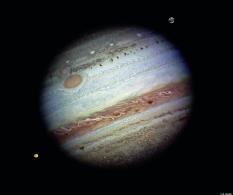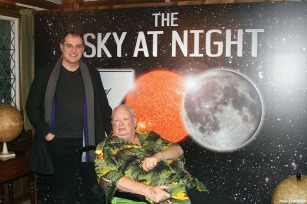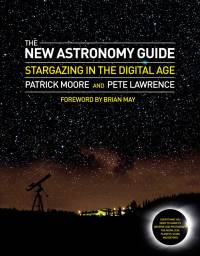Finally, an astronomy book we can all understand. Written by Pete Lawrence, the legendary Sir Patrick Moore and with a foreword by Brian May, The New Astronomy Guide is a star-studded introduction to astronomy.
We are even giving you a chance to get 50% off this brand new book, but first, Pete Lawrence answers our questions –
You were inspired by Patrick Moore when you were younger, what is it like working with him now?
Always fascinating. Patrick has a sharp mind and many years of astronomical knowledge to hand. It’s always a pleasure to chat to him as he’s able to come up with information which sometimes is a bit of a surprise. An example was a conversation I had with him about imaging a 700m wide ‘crack’ in the centre of the lunar alpine valley. During the conversation, Patrick dropped in that he was the one that first saw that feature!
You were interested in astronomy from a young age, what piqued your interest?
I genuinely can’t remember. I had access to lots of encyclopaedias owned by my grandfathers, when I was young and I used to be fascinated dipping in and out of them. Both grandfathers had an interest in astronomy so it’s likely that they biased the articles I read in the encyclopaedias. I remember trying to save up for a telescope that was advertised in the Exchange and Mart, when I was very young. However, I was never that good at saving my pocket money so I was never able to afford it. My parents bought me a 40mm refractor for an early birthday and I used that a lot to discover astronomical objects. The Apollo mission also had a big influence at getting me excited about space.
You’ve taken some amazing images – have you ever put yourself in a dangerous situation to get a great photo?
When the urge to get a photo kicks in, personal safety does tend to take a back seat. Having said this, astronomy isn’t an ‘extreme’ sport so most of the shots can be taken in safety.
I do a lot of solar imaging – that requires you to be very careful because the Sun is potentially a very dangerous target when focused through a telescope. During the recent transit of Venus, I was trying to obtain a very rare and special picture. As Venus gets closer to the Sun in the sky, it’s atmosphere appears as a complete ring of light. Catching this shot requires you to point the telescope dangerously close to the Sun without a filter. With a computer controlled telescope, the feat is made a lot easier, but I was in Svalbard on the gravel path outside of my hotel. It took a while to locate Venus but I managed it and got the shot.
Have you ever discovered anything new that got you really excited?
Lots of astronomical things get me excited. It’s the thrill of photographing something that no one else, or at least only a small handful of people, have ever photographed before. I particularly like event driven astronomy – a term which I use to describe things which are a one-off or rare. I was keen to add a chapter on this type of astronomy in the book as for me, it represents the ‘storm-chasing’ aspect of astronomy. Things like solar eclipses, the transit of Venus, occultations of planets by the Moon (that’s where the Moon passes in front of a planet) are just some examples.
There are examples of these special projects on my website at www.digitalsky.org.uk, under the “Projects” heading.
What is the most spectacular event that you have witnessed in your career … did you photograph it?
I get asked this a lot and it’s impossible to give a single answer. A total eclipse of the Sun is hard to beat and I’ve been lucky enough to see two now as well as experiencing the darkening due to totality from just outside Looe in 1999. A bright auroral display is also something not to be missed and I’ve seen many of these now – each one takes my breath away. I’ll never tire of seeing the planets highly magnified on my laptop screen when I’m imaging them and the Sun puts on a spectacular show when viewed with a specialist hydrogen-alpha filter. A huge prominence leaping off the Sun’s edge is something that really puts you in your place!

From The New Astronomy Guide: Amateur astronomer Damian Peach’s prize-winning photograph of Jupiter, Io (left) and Ganymede. The image was taken through Damien’s 14-inch SCT telescope from Barbados.
What should the amateur enthusiast be looking out for in the next few weeks?
The Moon passes very close to the planet Jupiter in the early hours of July 15th. If you live in the far north of the UK, the Moon will miss the planet. Further south the Moon will clip the planet’s disc. In the southeastern corner of the country, the Moon will cover Jupiter altogether. In August there’s the Perseid meteor shower. This peaks on August 12th unfortunately during the day. Nevertheless, looking out on the nights of 11/12 and 12/13 August should throw up a meteor or two. If you see a bright meteor streaking across the sky, be warned though, because this can hook you in for the rest of the night!
The period from late May through to early August is also good for a rare phenomenon known as Noctilucent Clouds (NLC’s). The name literally means “night shining” and is a reference to the fact that these mysterious electric blue clouds appear to shine when the Sun is below the horizon. If they are there, you should be able to see them low in the northwest, say between 22:00 and 23:00 BST. They may also be seen low in the northeast between 02:00 and 03:00 BST. A bright display may take no notice of these suggested times and can be visible all night long! They are due to a thin layer of water ice at heights of around 50 miles which can catch the Sun’s rays when it’s well below the northern horizon.
Do you like sci fi?
I love Sci-Fi and yes I did go to see Prometheus and yes, I loved it! Personally, I think Sci-Fi is important as it allows us to ‘play’ with our ideas. I love the depiction of future tech on films and TV series, especially when that tech is surpassed by what has actually come to pass!
From your experience do you think that there is an ‘edge’ of the universe?
I can say what I like here because there is no one on the planet who can prove otherwise. The concept of an infinite Universe isn’t an easy one to have because we don’t experience anything like that during our everyday lives. I think the best way to answer the question is sit on the fence and use one of my co-author’s favourite sayings – we just don’t know!
To get your hands on the book for just £10 all you have to do is call 08445 768 122 and quote AD155.
This offer lasts for just 10 days so pick up the phone now!


